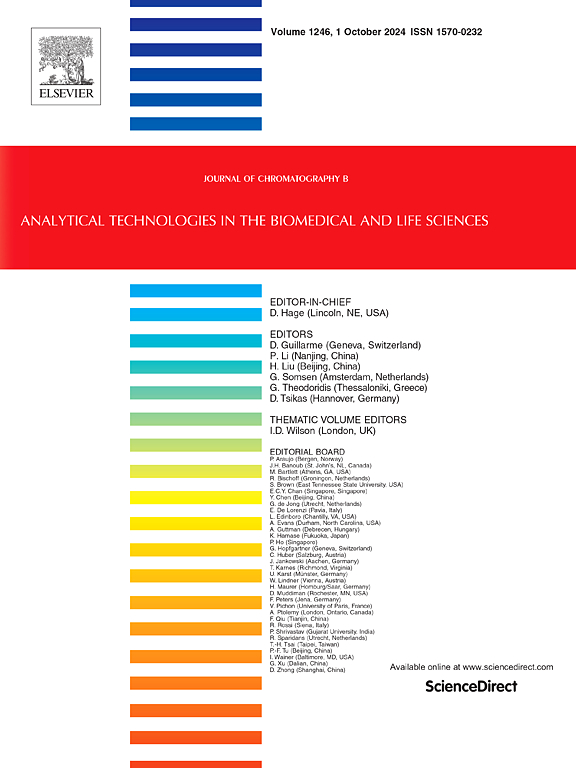绿色 RP-HPLC 法估测散装、纳米蛋白载体和人体血浆中的卡非佐米:化学计量学和蒙特卡洛模拟的应用
IF 2.8
3区 医学
Q2 BIOCHEMICAL RESEARCH METHODS
引用次数: 0
摘要
卡非佐米是一种四肽环氧酮,在治疗多发性骨髓瘤方面具有潜在的临床疗效。然而,由于稳定性差、溶解度低、技术耗时、理化性质复杂以及使用可回收性较差的非绿色溶剂等原因,此类多肽药物产品的定量存在误差。这就迫切需要开发一种生态、灵敏的分析方法,用于在制药行业产品开发的早期和横向阶段从基质配方和生物样本中量化多肽药物。因此,本研究旨在利用分析质量设计(AQbD)范式,通过绿色 RP-HPLC 开发一种稳健的生态方法来估算卡非佐米,并将其具体应用于蛋白质纳米颗粒和生物基质中。首先,利用主成分分析(PCA)这一化学计量学工具选择了合适的卡非佐米定量波长,然后利用 8 因子普拉克特-伯曼设计(Placket-Burman Design)进行了风险评估和因子筛选研究,从而确定了影响关键分析属性(CAA)的关键方法参数(CMPs)。此外,还采用了中央复合设计(CCD)进行设计空间优化,以确定最佳色谱条件,并通过蒙特卡洛模拟证实了这些条件的稳健性。根据 ICH Q2 (R2),对该方法进行了验证,随后使用绿色评估工具对该方法的绿色程度进行了量化。通过方法优化,使用绿色 RP-HPLC 确定了最佳色谱条件。色谱系统配置了 Phenomenex Aeris Peptide-XC C18 色谱柱(150 × 4.6 mm × 5 µm),流动相为异丙醇:甲醇:0.1 M PBS(pH 5.5,用 0.1 % 甲酸调节)(35:45:20v/v),流速为 1 ml/min,ʎmax 为 210 nm。优化色谱条件后,保留时间 (RT) 短至 4.95 分钟,尾随因子 (TF) 为 0.87,峰面积 (PA) 为 4875 122,理论平板数 (TPC) 为 8995。该方法在较宽的浓度范围(0.1-20 µg/ml)内线性关系良好,相关系数为 0.997,RSD 为 2%。该方法的精密度高,在纳米蛋白颗粒和人体血浆中的药物回收率超过95%,从而证实了所开发方法的准确性和灵敏度。化学计量学和蒙特卡洛模拟证实了所开发的卡非佐米分析方法的稳健性和灵敏度,而且绿色环保,在基于蛋白质的纳米制剂和人血浆基质的生命周期产品开发中具有很高的实用性。本文章由计算机程序翻译,如有差异,请以英文原文为准。
Green RP-HPLC method for the estimation of carfilzomib in bulk, protein nanocarriers and human plasma: Application of chemometrics and Monte-Carlo simulations
Carfilzomib is a tetrapeptide epoxyketone that has shown potential clinical outcomes in the treatment of multiple myeloma. However, inaccuracies in quantifying such peptide drug products have arisen due to poor stability, low solubility, time-consuming techniques, complex physicochemical properties, and use of non-green solvents with less recyclability. This provides a substantial urge to develop an ecological and sensitive analytical method for quantifying peptide drugs from matrix formulation and biological samples in early as well as lateral stages of product development in pharma industries. As a result, the study aimed to develop a robust ecological method for estimation of carfilzomib via Green RP-HPLC using analytical quality by design (AQbD) paradigms with specific application in protein nanoparticles and biological matrix. Initially, an appropriate wavelength for quantification of carfilzomib was chosen using principal component analysis (PCA) as a chemometric tool.Risk assessment followed by factor screening studies using 8-factor Placket-Burman Design aided in earmarking critical method parameters (CMPs) affecting critical analytical attributes (CAAs). Further, Central Composite Design (CCD) was employed for design space optimisation to demarcate optimum chromatographic conditions, which were corroborated for robustness using Monte-Carlo simulations. The method was validated as per ICH Q2 (R2), followed by quantifying the greenness of the method using Green Assessment tools. The method optimisation resulted in the optimal chromatographic conditions using Green RP-HPLC. The chromatographic system was equipped with a Phenomenex Aeris Peptide-XC C18 column (150 × 4.6 mm × 5 µm), and the mobile phase was composed of isopropanol:methanol:0.1 M PBS (pH 5.5 adjusted using 0.1 % formic acid) (35:45:20v/v), with a 1 ml/min flow rate at a 210 nm ʎmax. The optimised chromatographic conditions resulted in a short retention time (RT) of 4.95 mins, 0.87 tailing factor (TF), 4,875,122 peak area (PA), and 8995 theoretical plate count (TPC). The method demonstrated linearity in a wide range of concentrations (0.1–20 µg/ml) with a correlational coefficient of 0.997 and < 2 % RSD. The method unearthed a high precision rate with more than 95 % of drug recovery in protein nanoparticles and human plasma, thereby confirming the accuracy and sensitivity of the developed method. Chemometrics and Monte-Carlo simulations ratified the robustness and sensitivity of the developed analytical method of Carfilzomib with established greenness and a high degree of practical utility in protein-based nano formulations and human plasma matrix for life cycle product development.
求助全文
通过发布文献求助,成功后即可免费获取论文全文。
去求助
来源期刊

Journal of Chromatography B
医学-分析化学
CiteScore
5.60
自引率
3.30%
发文量
306
审稿时长
44 days
期刊介绍:
The Journal of Chromatography B publishes papers on developments in separation science relevant to biology and biomedical research including both fundamental advances and applications. Analytical techniques which may be considered include the various facets of chromatography, electrophoresis and related methods, affinity and immunoaffinity-based methodologies, hyphenated and other multi-dimensional techniques, and microanalytical approaches. The journal also considers articles reporting developments in sample preparation, detection techniques including mass spectrometry, and data handling and analysis.
Developments related to preparative separations for the isolation and purification of components of biological systems may be published, including chromatographic and electrophoretic methods, affinity separations, field flow fractionation and other preparative approaches.
Applications to the analysis of biological systems and samples will be considered when the analytical science contains a significant element of novelty, e.g. a new approach to the separation of a compound, novel combination of analytical techniques, or significantly improved analytical performance.
 求助内容:
求助内容: 应助结果提醒方式:
应助结果提醒方式:


